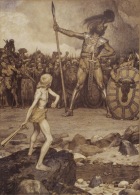In Why David Sometimes Wins: Leadership, Organization, and Strategy in the California Farm Worker Movement (Oxford, 2009), Marshall Ganz tells the story of Cesar Chavez and the farm workers’ victory over the giant food business. He draws the connection to the biblical of story of David and the giant, Goliath. Young David couldn’t come close to matching Goliath’s brute strength but he was smart and good with a slingshot and brought the brute down with a strategically aimed and accurately shot small stone to pierce through a hole in Goliath’s head armor. Goliath fell to the ground. David used Goliath’s own sword to cut off his head. When the Philistine’s saw their fearsome hero dead, they fled. The Israelites pursued and killed them.
How many of us feel small against the juggernaut of all that is hard in these times?
Colleagues in education caution against using war terminology and images in our thinking about etching and learning. I understand their argument on most days. But there are some days in schools where I feel like I’m seeing an opposing army on the other side of a valley, an army with a giant to do their battle for them.
Though I’m not literally looking to do physical damage, I look for the openings in the system’s armor to do work we believe is crucial for kids. In a district where data cycle team meetings were mandated for every school, one department found an opening to look at actual student work as informative data in addition to standardized test scores. The protocol provided a scaffold for more detailed evidence of student learning and gaps that led to collaboratively developed and targeted next steps in instructional practice. They also used a version of the same protocol to look at quantitative data from their students’ classroom work.
Links to protocols:
http://schoolreforminitiative.org/doc/atlas_lfsw.pdf
http://schoolreforminitiative.org/doc/atlas_looking_data.pdf
The story of David reminds me to continually check out the lay of the land, listen and learn about opposition, look for openings, cracks in the system, where we can do what matters for our world and our students’ lives.

